Apply now to join our next cohort of Community Science Fellows and Community Leads!
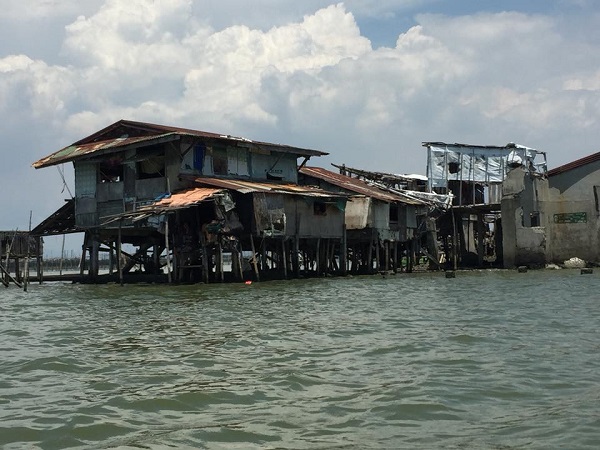
Photo Credit: AKAP KA-Manila Bay
Bulacan is a province in the Philippines just north of the national capital region of Manila. At 34% poverty incidence, fisherfolk comprise one of the poorest sectors of Philippine society yet contribute greatly to the country’s food security. However, these communities are in danger of being displaced, their sources of livelihood destroyed, and the environment at risk in order to make way for massive land reclamation projects that claim to be development projects that will improve the economy and local communities’ everyday lives. The San Miguel Corporation (SMC) has plans to develop a 2,500-hectare Aerotropolis. The project is planned to be a metropolitan subregion where the layout, infrastructure, and economy are centered on an airport which serves as a multimodal “airport city” commercial core. Construction of the Aerotropolis would require removal of the already-vulnerable coastal communities.
The Bulacan community science team used satellite imagery, hazard data, and field work data to assess the physical condition of the study areas. They used Geographic Information System (GIS) for map creation and assessment of the study areas. The team collected data via field surveys and online data sets.
The project team met almost once a month via Skype and several times (3-4 times in person to discuss the context and objectives of the project. In addtion, they discussed any troubleshooting issues and individual roles and responsibilities, as they evolved. Overall time involved: approximately 2 months for doing the maps starting from data collection to production of maps.
The team produced three types of maps: storm surge maps, flood maps for different scenarios and location maps.
This project enabled the communities in Taliptip, Bulakan, Bulacan to better understand and prepare for geohazards (e.g. storm surge and flooding) that their area may face in case of extreme events. Because of this project, they now understand that they would need to be more vigilant and if possible, look for a better site where they could build their houses. At the same time, many have come to understand that these geohazards should not be used to justify being displaced from their homes. They now know that building a large-scale project such as an aerotropolis would not only impact their locality but may exacerbate the hazards in other areas as well.
In the case of the community members, they use their interaction with researchers and the possible impact of the aerotropolis to organize themselves and others and to express their dissatisfaction against the impending construction of the aerotropolis.
Some factors that contributed to this team’s success include:
For those seeking to do community science projects, the team recommends that those teams engage in constant engagement with everyone involved (e.g. AGU – Thriving Earth Exchange, community members, and scientists) especially when it comes to they types of outcomes that are possible given a limited time and limited resources.
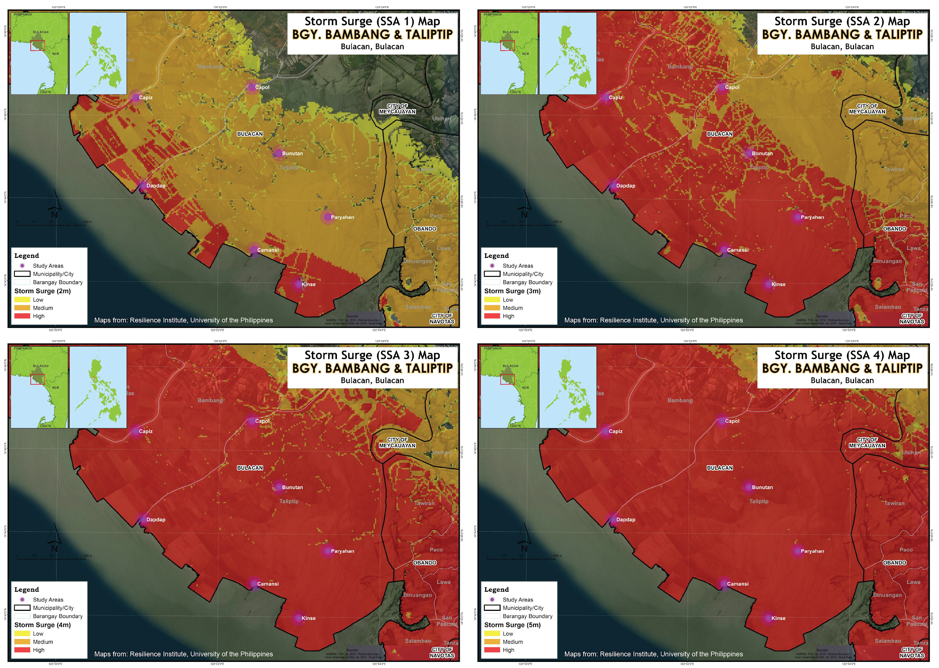
Storm surge hazard maps showing the probability of inundation by storm surges in the coastal communities of Bulakan, Bulacan, with the different Storm Surge Advisories. The sitios of Brgy. Taliptip are shown as purple dots. Increasing probability is shown from yellow to orange to red. Storm surge modelling conducted by J. Mendoza and J. Santiago.
Fisherfolk and their larger communities depend on the ecosystem of the Manila Bay coastal areas of Bulacan for their livelihood, for example, the 40,000 residents of the municipality of Paombong, Bulacan. Bulacan is a province in the Philippines just north of the national capital region of Manila. At 34% poverty incidence, fisherfolk comprise one of the poorest sectors of Philippine society yet contribute greatly to the country’s food security. However, these communities are in danger of being displaced, their sources of livelihood destroyed, and the environment at risk in order to make way for massive land reclamation projects that claim to be development projects that will improve the economy and local communities’ everyday lives.
While reclamation projects can be a source of much needed development that local communities need, the current findings from an expert geologist strongly suggest that an urgent and extensive research study needs to be conducted to mitigate—if not altogether prevent—the possible harmful effects on the environment and the people that these projects may cause in Bulacan. The specific objective of this project is to understand the impacts of reclamation and road projects along Manila Bay upon the community of Bulacan.
Residents have reported that representatives of so-called Silvertines Incorporated, an alleged consortium of big investors in the Philippines, have been bothering them about buying out vast areas of fish ponds. Over 3,000 hectares of fish ponds have already been procured. Fisherfolk have started to experience dwindling catches due to large-scale fish cage farms now operated by Silvertines Corporation.
Further, the San Miguel Corporation (SMC) has already published several press releases about developing a 2,500-hectare Aerotropolis. The project is planned to be a metropolitan subregion where the layout, infrastructure, and economy are centered on an airport which serves as a multimodal “airport city” commercial core. Construction of the Aerotropolis would necessarily require removal of the already-vulnerable coastal communities.
With preliminary consultation from University of Illinois at Chicago geologist Dr. Kelvin Rodolfo, the community has learned that the reclamation project has a lethal risk for aggravating geophysical hazards. In particular, the hazards include danger of land subsidence; danger of storm surge and strong waves caused by typhoons; and danger from seismically induced liquefaction.
The project would have far-reaching impacts beyond the province of Bulacan. San Miguel Corporation’s Aerotropolis is only part of a larger reclamation project called the Manila Bay Integrated Flood Control, Coastal Defense, and Expressway Project proposed by the Coastal Development Consortium (CDC). The CDC is composed of the New San Jose Builders Inc. and the San Miguel Holdings Corp., a subsidiary of the San Miguel Corporation. Later, this project could be replicated to cover not only the coast of Bulacan but also the provinces of Pampanga and Bataan. The output of the project will not only inform, but also empower affected communities for education and awareness building to strengthen the community-based organization and lobbying with the legislators for policy advocacy.
Feny Cosico and John “Warner” Carag have selected Joy Santiago and Jake Mendoza as their scientific leads. Joy and Jake will:
The community anticipates that Joy and Jake will:
This project started in February 2019 and will take approximately 6-8 months to complete.
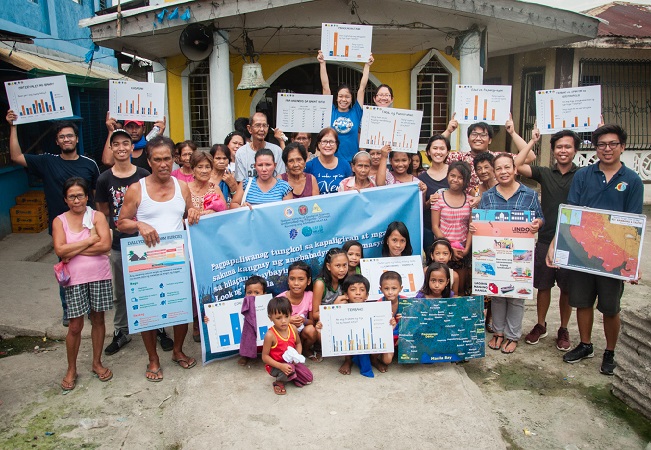
The Bulacan, Philippines team is getting close to having hazards maps vetted with the 7 communities of Bulacan province along Manila Bay. The hazards simulation that Joy Santiago and Jake Mendoza planned to do in June will occur in the next couple of weeks with the expectation that they will have sufficient information for AKAP-KA Manila Bay community leaders to provide guidance as to who will be affected by increased storm surge, should the aerotropolis development proceed.
In the words of John “Warner” Carag, the AGHAM representative with the Thriving Earth Exchange project:
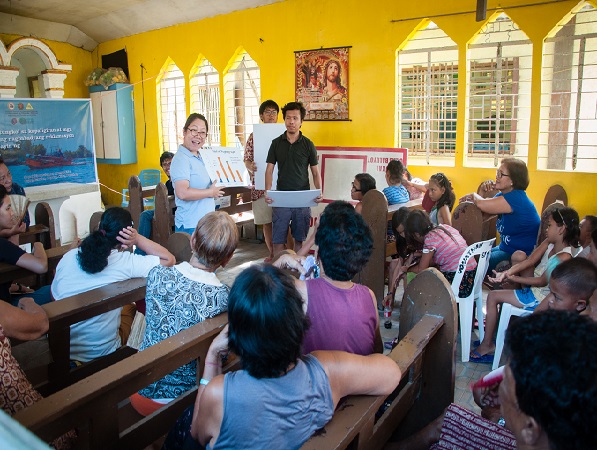 Bulacan is not the only province along Manila Bay facing reclamation issues. Thus, the project team plans to writ up their methodology so that AGHAM and AKAP-KA can replicate this project all along Manila Bay.
Bulacan is not the only province along Manila Bay facing reclamation issues. Thus, the project team plans to writ up their methodology so that AGHAM and AKAP-KA can replicate this project all along Manila Bay.
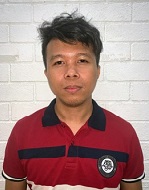 Warner Carag is a biologist and the Secretary-General of Advocates of Science and Technology for the People or AGHAM – Diliman Chapter. Warner served as a biologist during AGHAM’s Environmental Investigation Mission which assessed the impact of the Jalaur River Multi-Purpose Project in Panay island, Philippines, the first large scale dam project in the Visayas area. He is also a graduate student in the National Institute of Geological Sciences, University of the Philippines – Diliman.
Warner Carag is a biologist and the Secretary-General of Advocates of Science and Technology for the People or AGHAM – Diliman Chapter. Warner served as a biologist during AGHAM’s Environmental Investigation Mission which assessed the impact of the Jalaur River Multi-Purpose Project in Panay island, Philippines, the first large scale dam project in the Visayas area. He is also a graduate student in the National Institute of Geological Sciences, University of the Philippines – Diliman.
AGHAM-Advocates of Science and Technology for the People is the partner national organization. AGHAM, is an organization of patriotric, pro-people science and technology advocates, bounded together by a common interest of promoting science and technology that genuinely serve the interest of the Filipino people, especially the poor.
(c) 2024 Thriving Earth Exchange